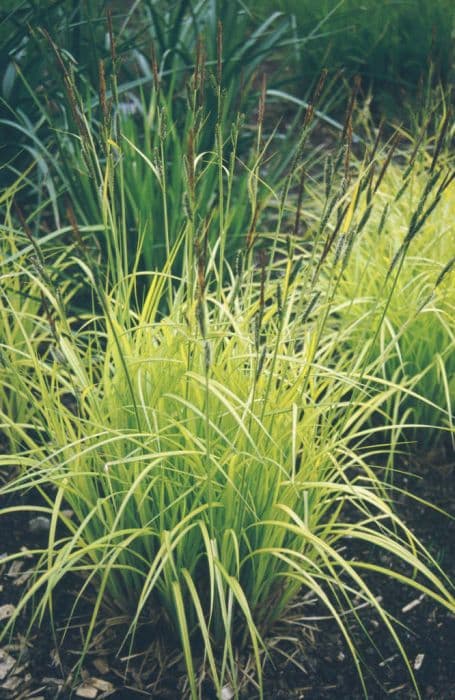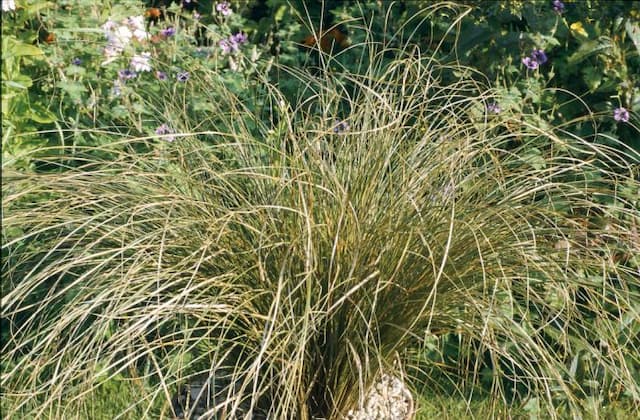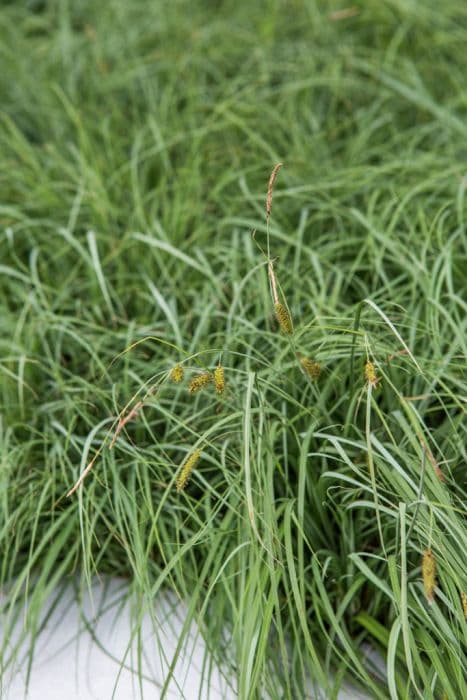Fiber Optic Grass Isolepis cernua

ABOUT
The plant commonly known as Fiber Optic Grass or Slender Club Rush has a distinctive and attractive appearance reminiscent of a spray of fine green threads or fibers that seem to cascade outwards from a central base. Its foliage is composed of thin, wiry blades that are flexible, giving the impression of softness and movement. The color of the leaves is a vibrant green, contributing to its lush and grassy texture. During the flowering season, tiny yellowish-green or brownish flowers emerge, looking almost like small beads at the tips of the stems. These flowers give the impression that the plant is glowing or lit up, similar to how fiber optic strands might appear to shine at their ends, thus earning it the common name Fiber Optic Grass. The overall form of the plant is graceful and fountain-like, with the fine foliage often bending slightly under its own weight, enhancing the image of a delicate fiber optic display.
About this plant
 Names
NamesFamily
Cyperaceae.
Synonyms
Fiber Optic Plant, Nodding Club Rush, Slender Club-rush, Low Bulrush, Seed Shrimp.
Common names
Scirpus cernuus, Isolepis cernua.
 Toxicity
ToxicityTo humans
The plant commonly known as Fiber Optic Grass (Isolepis cernua) is not known to be toxic to humans. While it does not possess any significant poisonous traits, it is always advisable not to ingest plant material that is not established as safe for consumption. In general, consuming non-food plants can potentially cause gastrointestinal discomfort or more serious complications depending on the plant's specific chemical makeup.
To pets
Fiber Optic Grass (Isolepis cernua) is generally considered to be non-toxic to pets. This means that it is not expected to pose a risk of poison to cats and dogs if they happen to ingest it. However, as with humans, ingestion of non-food plants can potentially lead to mild gastrointestinal upset in pets, such as vomiting or diarrhea, due to the irritation of the digestive tract or from the plant matter's physical properties.
 Characteristics
CharacteristicsLife cycle
Perennials
Foliage type
Evergreen
Color of leaves
Green
Flower color
Brown
Height
1 foot (30 cm)
Spread
1 foot (30 cm)
Plant type
Herb
Hardiness zones
8
Native area
South Africa
Benefits
 General Benefits
General Benefits- Ornamental value: Isolepis cernua, commonly known as fiber optic grass, is often used in gardens and landscaping for its unique, grass-like appearance and for its delicate, weeping shape that adds texture and movement to garden compositions.
- Low maintenance: Fiber optic grass is easy to care for, requiring minimal maintenance aside from occasional watering and trimming, making it ideal for those who desire an attractive garden without extensive upkeep.
- Drought tolerance: Once established, this plant has a good tolerance to drought conditions, which is beneficial for water conservation in arid climates or during summer months with low rainfall.
- Suitable for containers: Due to its compact size, fiber optic grass is well-suited for container gardening, allowing those with limited space such as balconies or small patios to enjoy greenery.
- Wildlife attraction: Isolepis cernua can attract wildlife such as birds that may use the plant for nesting material or as a habitat, promoting biodiversity in a garden setting.
- Erosion control: This plant can be used effectively for erosion control, as its roots help to bind the soil, making it an excellent choice for sloped areas in the landscape or near bodies of water.
- Flexibility in planting: Fiber optic grass can thrive in a variety of soils and is suitable for planting in a wide range of hardiness zones, demonstrating adaptability to different environmental conditions.
- Seasonal interest: Providing visual interest throughout the growing season, Isolepis cernua remains an attractive green during mild winters, adding year-round beauty to gardens in suitable climates.
 Medical Properties
Medical PropertiesThis plant is not used for medical purposes.
 Air-purifying Qualities
Air-purifying QualitiesThis plant is not specifically known for air purifying qualities.
 Other Uses
Other Uses- Fiber Source: The stems of Isolepis cernua, commonly known as Fiberoptic Grass, can be used to make small-scale craft items such as decorative braids or simple baskets due to their slender and flexible nature.
- Erosion Control: Due to its mat-forming habit, Fiberoptic Grass can help stabilize soil in garden landscapes that are prone to erosion.
- Livestock Feed: Though not a primary choice for fodder, Fiberoptic Grass can be grazed upon by livestock when other preferred forage plants are not readily available.
- Water Garden Accent: The grass's distinctive appearance, with its fiber optic-like tips, can be used to enhance the aesthetics of water gardens or ponds.
- Photography Prop: Its unique structure that resembles fiber optics makes it a popular plant for photographers looking for intriguing subjects in macro photography.
- Education: Fiberoptic Grass can be used as an educational tool to demonstrate plant structure and adaptation in wet environments to students.
- Garden Borders: Gardeners may use Fiberoptic Grass to create soft and flowing garden borders that move in the wind, providing a sense of movement in the garden.
- Floral Arrangements: This grass can be incorporated into floral arrangements to add a fresh, green touch and texture variation amidst flowers.
- Living Mulch: When planted densely, Fiberoptic Grass can serve as a living mulch, helping retain moisture in the soil and suppress weeds in cultivated beds.
- Habitat Creation: Fiberoptic Grass can also be planted to provide habitat and breeding grounds for small aquatic fauna like frogs in a backyard pond or naturalized area.
Interesting Facts
 Feng Shui
Feng ShuiThe plant Isolepis cernua, commonly known as fiber optic grass, is not used in Feng Shui practice.
 Zodiac Sign Compitability
Zodiac Sign CompitabilityThe plant fiber optic grass is not used in astrology practice.
 Plant Symbolism
Plant Symbolism- Flexibility: Isolepis cernua, commonly known as fiber optic grass, has slender and bending stems, which often symbolize flexibility and the ability to adapt to changing circumstances.
- Connection: The interwoven nature of its grass-like leaves can represent connectivity and the intertwining of lives, reflecting the interconnectedness of all things.
- Illusion: Given its nickname "fiber optic grass," it can symbolize illusion or a sparking of ideas, as it may visually resemble the technology of fiber optics used in communication.
- Perseverance: As it's a plant that can grow in wet, boggy conditions, it symbolizes the ability to thrive and persist in less-than-ideal situations.
 Water
WaterThe Isolepis cernua, commonly known as fiber optic grass, requires consistent moisture and should be watered when the top inch of soil begins to dry out. It is often best to water fiber optic grass at least once a week, providing enough water to soak the soil thoroughly. Depending on the environmental conditions and the size of the pot, this may translate to around 8 to 16 ounces of water for a pot with a diameter of 6 inches. During the hot summer months, watering frequency should increase to maintain the moisture level. In contrast, winter watering should be reduced as the plant's growth slows down.
 Light
LightFiber optic grass thrives in bright, indirect light but can also tolerate partial shade. It's ideal to place the plant in a spot where it can receive morning sunlight but is protected from the intense afternoon sun. A north or east-facing window is often a good spot for providing optimal light conditions for fiber optic grass without risking sunburn.
 Temperature
TemperatureFiber optic grass prefers moderate temperature conditions and performs best in a range between 60 and 75 degrees Fahrenheit. It can survive minimum temperatures of around 50 degrees Fahrenheit but should be protected from frost. Avoid exposure to temperatures above 80 degrees Fahrenheit, as excessive heat can stress the plant.
 Pruning
PruningPruning fiber optic grass is essential to maintain its tidy appearance and encourage new growth. Trim back the tips of the plant when they start to look brown or unhealthy, usually once during mid-spring and again in early fall. Use sharp, clean scissors or pruning shears to cut back up to one-third of the plant's length if necessary.
 Cleaning
CleaningAs needed
 Soil
SoilFibrous Club Rush thrives best in a soil mix that is evenly moist, well-draining and rich in organic matter. A mix consisting of peat, sandy soil, and a bit of loam would be ideal, providing both moisture retention and aeration. The pH should be slightly acidic to neutral, ranging from 6.0 to 7.0.
 Repotting
RepottingFibrous Club Rush should be repotted every 1-2 years to ensure it has enough room for growth and to replenish its soil. The best time to repot is during spring or early summer.
 Humidity & Misting
Humidity & MistingFibrous Club Rush prefers high humidity levels, ideally between 60% to 70%. It will thrive better if the surrounding air is moist, which can be aided by placing a humidifier nearby or grouping it with other plants to create a microclimate.
 Suitable locations
Suitable locationsIndoor
Place Fibrous Club Rush in bright, indirect light and maintain high humidity.
Outdoor
Provide semi-shade and moist soil for Fibrous Club Rush outdoors.
Hardiness zone
8-10 USDA
 Life cycle
Life cycleIsolepis cernua, commonly known as fiber optic grass or fairy lights, starts its life cycle as a seed, requiring damp conditions to germinate. After germination, seedlings quickly develop into clumps of fine, hair-like green stems, resembling fiber optic threads, thriving in wet or boggy conditions. As the grass matures, it grows small, inconspicuous brown to greenish flowers at the tips of the stems during the summer months. Following pollination, which is mostly self-performed or aided by wind, it produces small nuts as fruits which contain the seeds. In ideal growing conditions, fiber optic grass is a perennial, returning each year by sprouting from the root system, but it can also be grown as an annual in colder regions where it does not survive the winter outdoors. Periods of rest or dormancy can occur when the plant is subjected to dry conditions, but it quickly revives and resumes growth once proper moisture levels are restored.
 Propogation
PropogationPropogation time
Spring to summer
Propogation: Isolepis cernua, commonly known as Fiber Optic Grass, is often propagated through division, which is the most popular method for this particular plant. This process typically occurs in the spring when the plant's growth is most active. To propagate by division, carefully remove the plant from the pot or ground and gently separate the clump into smaller pieces, ensuring each new section has a portion of the roots. Replant these divisions immediately into well-draining soil, maintaining adequate moisture until the new plants are established. It's recommended to space the divisions about 6 to 12 inches (15 to 30 centimeters) apart to allow for ample growth and airflow.







![Japanese sedge [Everest]](/_next/image?url=https%3A%2F%2Fplants-admin.emdemapps.com%2Fimages%2Fplants%2F%2Fimages%2F604b5b6de0548.png&w=640&q=75)

